In the vast and varied landscapes of East Nusa Tenggara (Nusa Tenggara Timur or NTT), innovation doesn’t just mean new technology. It means survival. For many communities across this archipelagic province, daily life is shaped by scarcity: of water, electricity, and reliable infrastructure. But it’s also shaped by resilience, creativity, and a deep sense of adaptation.
This is where Kuantek, short for Kuan Timor Technology (Teknologi Kampung Timor), is planting its roots and building climate solutions that emerge not from abstract theory, but from the lived experiences of the people they aim to serve.
Co-founders Ben Vasco Tarigan, Abraham Talluta (CEO), and Abdi Nenotek (CTO) do not claim to have all the answers to NTT’s struggles. But they do have one thing that many technology companies overlook: they listen.
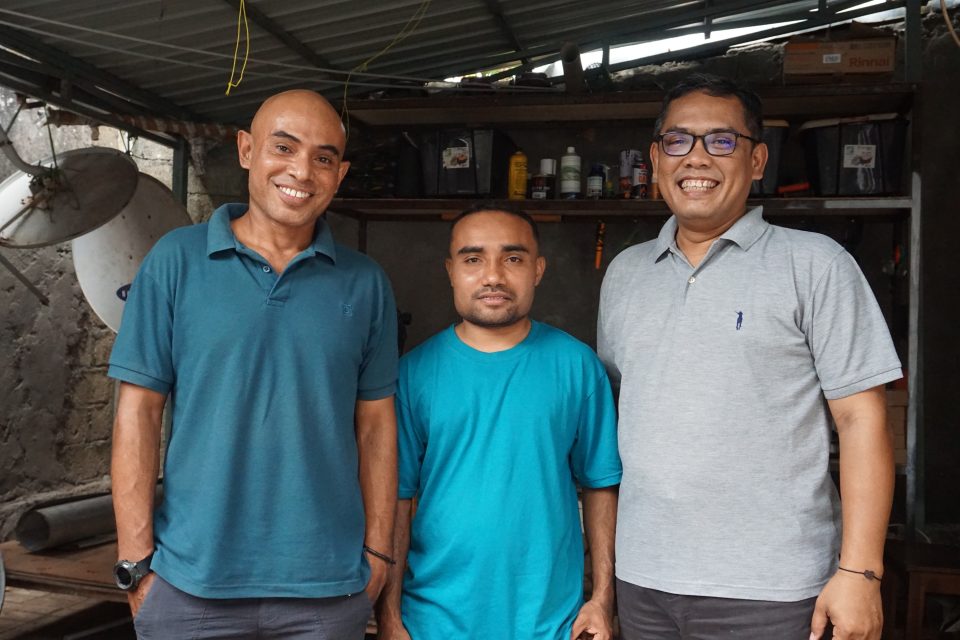
Kuantek Co-Founders: Abraham Talluta (CEO), Abdi Nenotek (CTO), and Ben Vasco Tarigan.
“We always ask our users: Apa yang paling menyakitkan? What’s the most painful part of your day?” says Ben. “We design our products from there.”
To Kuantek, listening isn’t just a design principle – it’s their business model.
Three years after its founding, Kuantek connected with New Energy Nexus Indonesia through the IKEA Foundation-funded Smart Energy Incubation Program and the [RE]Spark Hackathon. At the time, they had a clear target – addressing NTT’s lack of access to clean water. Their solution was to build an affordable seawater desalination system to produce drinkable water for coastal communities.
From this one idea, Kuantek kept evolving. They began developing a range of environmental technologies designed to address the needs of rural and remote populations, from preserving produce with little energy cost to making water out of air.
The three innovators weren’t siloed in labs. Instead, they co-created their products with the very communities that will reap the benefits. Each innovation started with a simple premise: Making life easier, using what the community already has.
One of Kuantek’s most talked-about products is their low-power dehydrator, a tool that’s now helping farmers in Timor dry and preserve chili and vanilla crops for longer shelf life and higher selling prices.
Getting dehydrators is a smart economic move for farmers. It allows farmers the option to dry and store fresh produce, instead of having to sell it quickly to avoid spoilage. This gives them more control over pricing and market timing.
However, commercial dehydrators often require up to 1000 watts to operate, and in rural areas such as those in Nusa Tenggara Timur, the power capacity per household only reaches up to 500 watts. That’s where Kuantek came in.
“We designed ours to run at just 270 watts,” says Ben. The secret is a combination of energy-efficient lighting systems and localized materials. “It’s not just about being energy-efficient. It’s about making sure people can actually use it.”
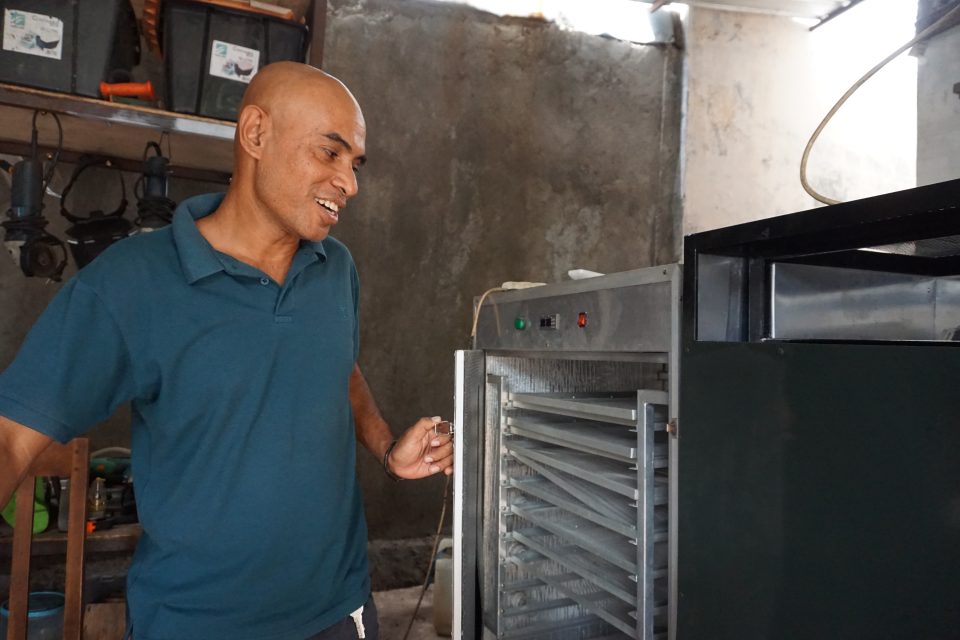
Kuantek’s low-watt food dehydrator
Another of Kuantek’s solutions is a system that converts humidity from the atmosphere into potable water, using solar energy. This technology is particularly suited for some areas in NTT, where air humidity is high, but water sources are often inaccessible or unsafe.
Ben envisions installing these atmospheric water systems in schools and highland tourism areas, especially in places where groundwater is either unavailable or requires expensive and unsustainable drilling.
“We want to eliminate the need for groundwater wells in hard-to-reach areas,” he said. “Instead, let’s use what we already have: heat, air, and sunlight.”
In a pilot project, they installed a solar thermal-powered water station in a coastal village. Three months later, the local pastor reported something profound: for the first time, they had no trouble getting clean water. “That’s when we knew we were doing something right,” Ben said.

Solar-powered water harvesting system
While their ideas may be bold, implementation is often difficult, as NTT’s geography presents a host of logistical barriers.
Some islands can only be accessed by small boats that can’t carry heavy machinery. Roads are narrow, winding, and poorly maintained. In many villages, bridges don’t exist, and rivers swell during the rainy season, cutting off access altogether.
This makes even the most well-designed product a challenge to deliver. Kuantek had to rethink their seawater desalination system when they realized the original version was too large for local transport networks.
“So we redesigned the whole thing to be smaller, but with the same capacity,” Ben explains. “It wasn’t just about making it small, it was about making the technology mobile, modular, and manageable.”
For Kuantek, the job doesn’t end at innovation. Often, it begins long before product design, and continues well beyond delivery.
Their team frequently plays the role of advocate, helping villages navigate complex systems like reporting power outages to PLN, the state-owned power company. They also introduce basic feedback mechanisms so that communities feel empowered to ask for improvements or raise concerns.
“Sometimes our work is as simple as showing people how to talk to PLN,” Ben said, laughing. “Other times, we’re advocating for completely new systems to be built.”
They are also aware of the challenges of behavior change. Many people in rural NTT have adapted to unreliable electricity and limited water access, often without realizing it. That makes introducing new technologies tricky.
“It’s incredibly difficult to ask someone to adopt new behaviors,” Abraham said. “So instead, we look at the things they’re already doing, and we design from there.”
This empathetic approach ensures that technologies don’t feel foreign or intrusive, but intuitive.
When it comes to criticism of their business, Ben sees it as very valuable insight. Rather than resisting feedback, they see it as an invitation to collaborate.
This philosophy has allowed Kuantek to keep improving, even with limited resources.
“Disagreements and pushback are something I see as gifts. When people tell us what’s wrong, they’re actually helping us make the product fit better,” he reflects. “It’s our job to listen, iterate, and make it real.”
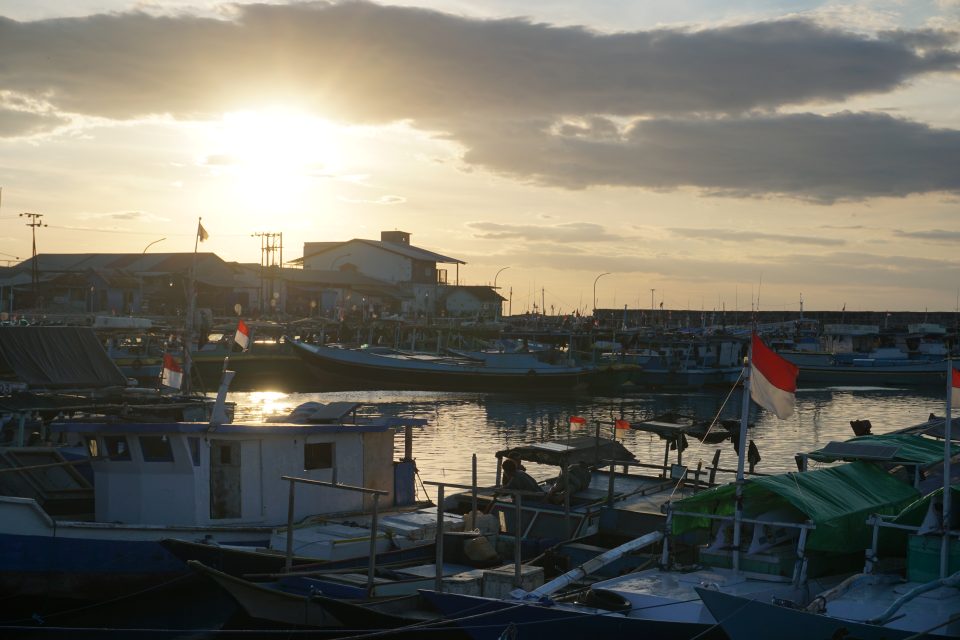
Kupang, East Nusa Tenggara
Looking to the future, Kuantek is embarking on an ambitious initiative: mapping the infrastructure, climate, and behavioral patterns of every district in NTT.
They want to build a data bank – a library of regional insights that can guide future innovations and help them develop tailored, low-emission technologies suited to each community’s unique needs.
“Some areas are hot, dry, and windy. Others are humid or rich in seawater. Every place is different,” says Ben. “But if we know the conditions, we can create the right solutions.”
Beyond the benefit to their business, Kuantek wants the database to be an open reference point for governments, entrepreneurs, universities, and other innovators who want to build effective, community-centered technology in rural Indonesia.
Their dream is to make technology accessible and replicable. “Even if it’s simple, if people understand how it works, they can build it themselves,” Ben says.
Kuantek sums up their entire approach in five words: “Datang, Duduk, Diskusi, Design, Diseminasi (5D),” which translates to “Come. Sit. Discuss. Design. Disseminate.
More than a method, it’s a mindset that values patience over speed, trust over disruption, and purpose over profit.
“Where there are a thousand problems, there are also a thousand solutions,” says Ben. “Our job is to figure out how to tackle them.”
For all the challenges NTT presents, the people soldier on every day to live on to the next. They are what inspires each small invention at Kuantek. In turn, the company’s technologies seek to ease their burdens and build a cleaner future, in NTT and beyond.
Want more clean energy stories and opportunities in Indonesia? Check out New Energy Nexus Indonesia here.
Ten pioneering startups from across the lithium battery value chain presented their vision of Australia’s battery sector to an engaged audience of investors, policymakers, and industry participants at the inaugural Supercharge Australia Incubator Pitch Day.
After three months of tailored support from EnergyLab and New Energy Nexus, these founders now stand poised to accelerate the country’s battery manufacturing capabilities – with solutions ranging from raw material innovation, marine applications, embedding safe energy storage into our living spaces, to cell reuse and repair.
Here are the participating startups and their lithium battery value chain focus:
The completion of the first Incubator marks a key milestone in Supercharge Australia’s broader mission – to support over 150 startups in the lithium battery value chain and catalyse a thriving, interconnected lithium battery innovation sector – by adding a second program focused on supporting earlier-stage startups. The new program provided mentorship, expert advice, pilot opportunities, early customer connections, investor engagement, and international exposure, helping the teams to build the foundations of Australia’s battery future. We thank all of the experts for their generous contributions.
Launched in 2022, Supercharge Australia has now completed two Innovation Challenges. With the addition of the Incubator, it is now supporting 31 startups that have raised over AU$71 million in funding since they participated in its programs.
Australia has a generational opportunity to move beyond exporting lithium ore and build a competitive, homegrown battery value chain. The startups in this year’s Incubator show how this is already taking shape: connecting technologies across the life cycle of a battery, from production to application to reuse. Their innovations don’t just solve isolated problems; they strengthen each link in the chain, multiplying impact along the chain to make the entire system cheaper, cleaner, and more efficient. This is how Australian batteries can compete.
Together, they demonstrate what a circular, high-value battery ecosystem could look like:
With coordinated support, these early-stage innovations can accelerate Australia’s transition from resource supplier to battery technology leader.
Australia remains the world’s leading lithium producer, supplying over one-third of global demand. With the global lithium battery market still forecast to be significantly undersupplied by 2030, Australian producers are seeking efficiency improvements and are investing in downstream opportunities to secure vertical capacity and greater profitability.
Each startup in the Incubator cohort is developing a critical piece of the emerging ecosystem and the kinds of investment opportunities the sector is seeking. Their solutions highlight the scale of opportunity when early-stage innovation is backed with intent, speed, and coordinated support.
While early traction for the cohort members was strong – from prototypes to paid pilots – the startups were all facing the same uphill challenge: securing capital, facilities, and support to go from validated concepts to scalable commercial impact. The Incubator addresses this gap by de-risking particularly early innovation, reducing barriers to commercialisation, and helping Australia retain its battery IP rather than lose it offshore.
As global warming trends continue toward a 3°C pathway, and the risks of overshoot, consequent tipping points, and heavy reliance on unproven carbon capture and storage technologies rise, building a high-functioning cleantech sector that can dramatically accelerate decarbonisation becomes a strategic, global imperative.
Batteries power the clean energy transition, making it an important piece of this response – and battery startups have tremendous potential to pave the way, especially when supported early.
To further develop this economic opportunity, Australia can adopt proven models like our CalTestBed program in California, which turned US$22 million in early-stage testing access into over US$438 million in follow-on investment by offering non-dilutive, non-matching grants to startups solving big climate problems. If a similar system were applied here, it would rapidly increase the volume and readiness of battery startups ready to attract private capital or integrate into gigafactory supply chains.
“Building Australian lithium battery capability begins with supporting innovation at its earliest stages — with non-matched and non-dilutive funding to produce prototypes, pilots and real-world testing opportunities,” said Kirk McDonald, Project Manager at Supercharge Australia.
Australia has a generational opportunity to do the same: Supercharge Australia is calling for new initiatives to:
To continue building the momentum for this sector, our next program is launching now. This will be our third Supercharge Australia Innovation Challenge – applications are open.


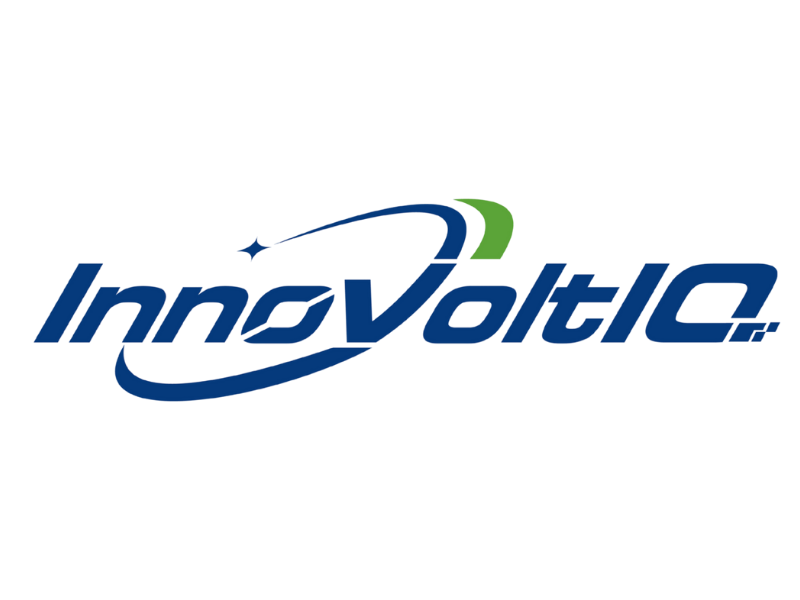
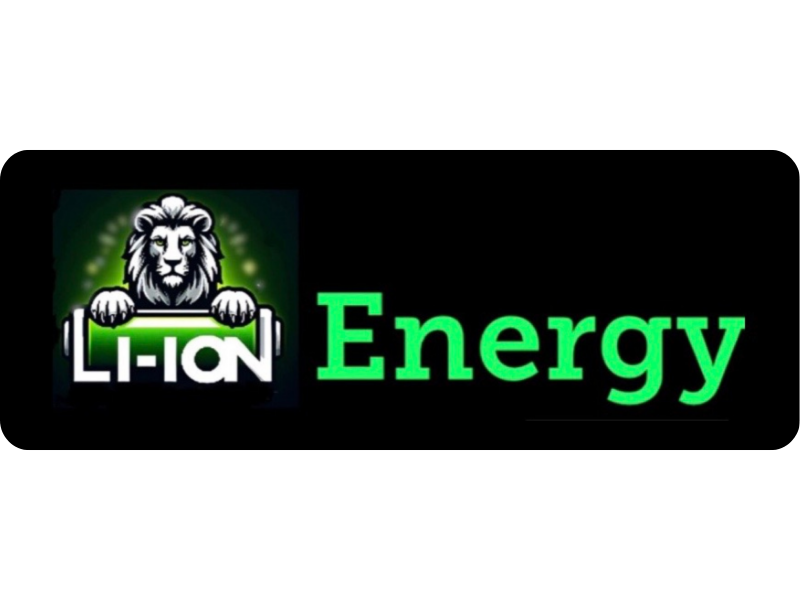
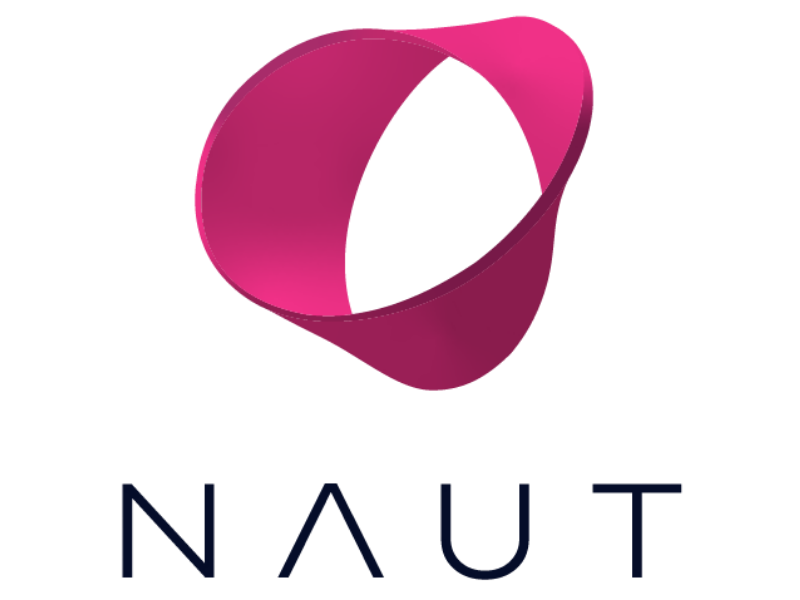


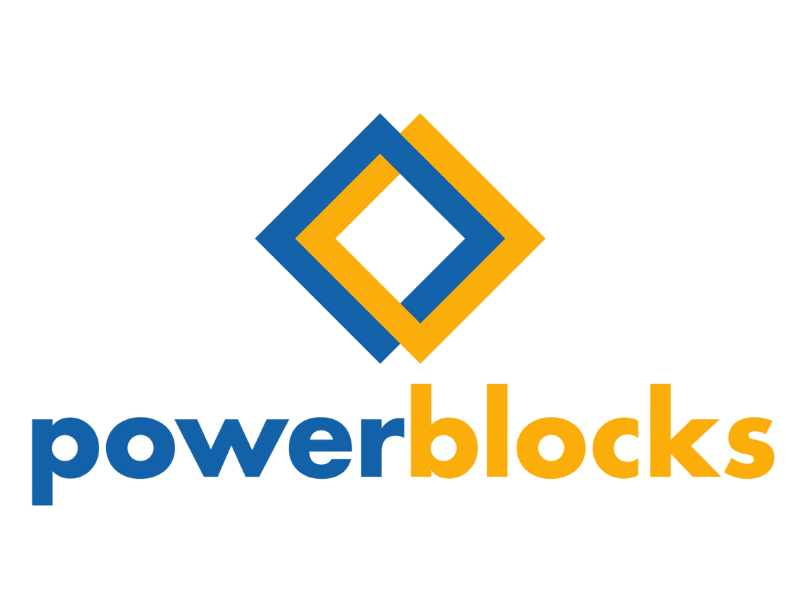
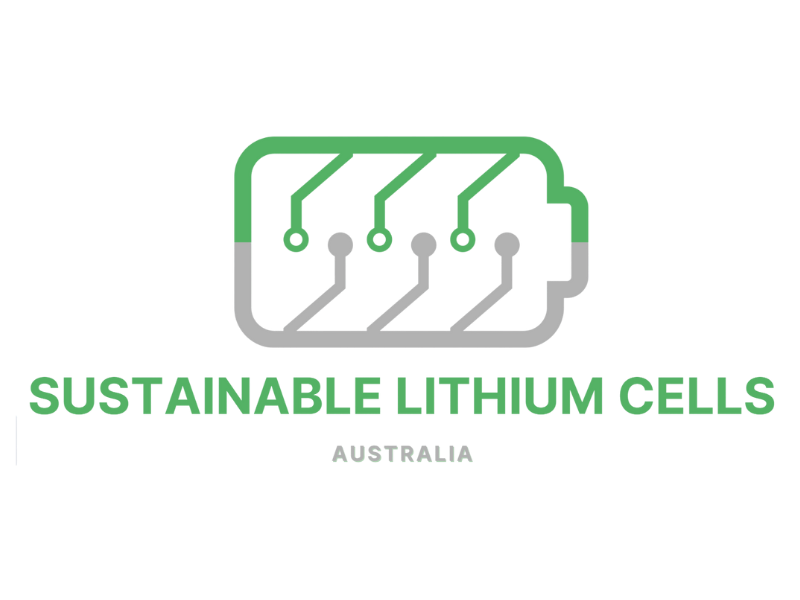

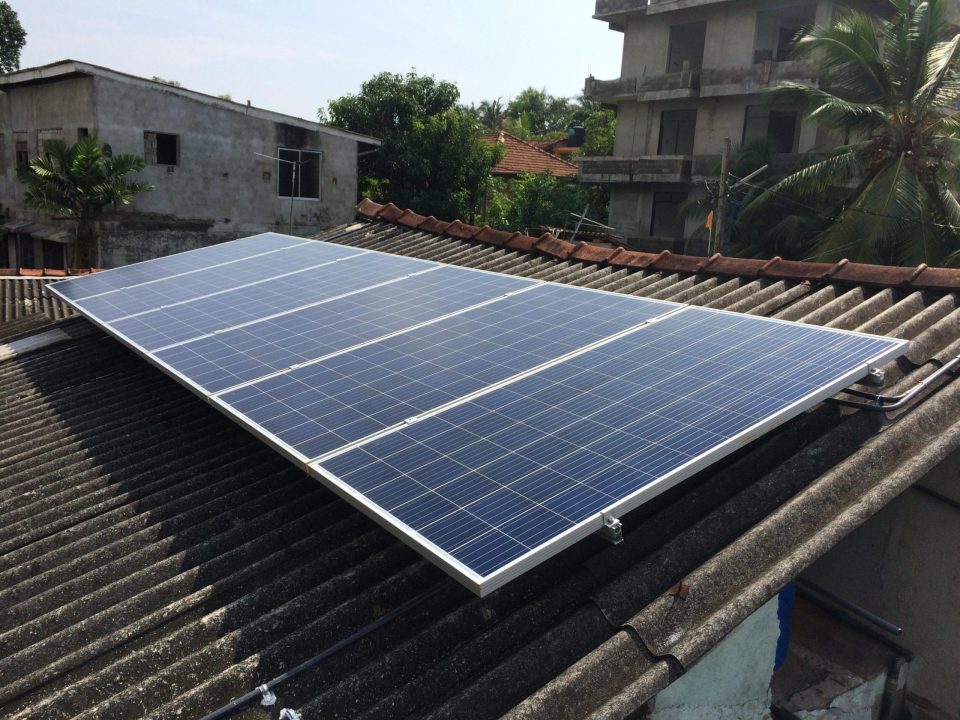
Rooftop solar panel. Stock photo
A recent study by Ateneo de Manila University, published in Challenges in Sustainability, sheds light on the persistent barriers preventing the widespread adoption of rooftop solar power (RTSP) in Metro Manila and nearby provinces. Led by Professor Rosalina Palanca-Tan, the study surveyed 403 respondents to understand why households remain hesitant to invest in solar technology despite its clear economic and environmental benefits.
The study’s findings were recently featured in the Philippine Daily Inquirer, sparking a public discussion on its Facebook post, which highlighted several recurring concerns: high upfront costs, lengthy return on investment (ROI) periods, bureaucratic hurdles, technical challenges, and a lack of government support. Let’s look into the key challenges raised around rooftop solar adoption, and explore potential solutions.
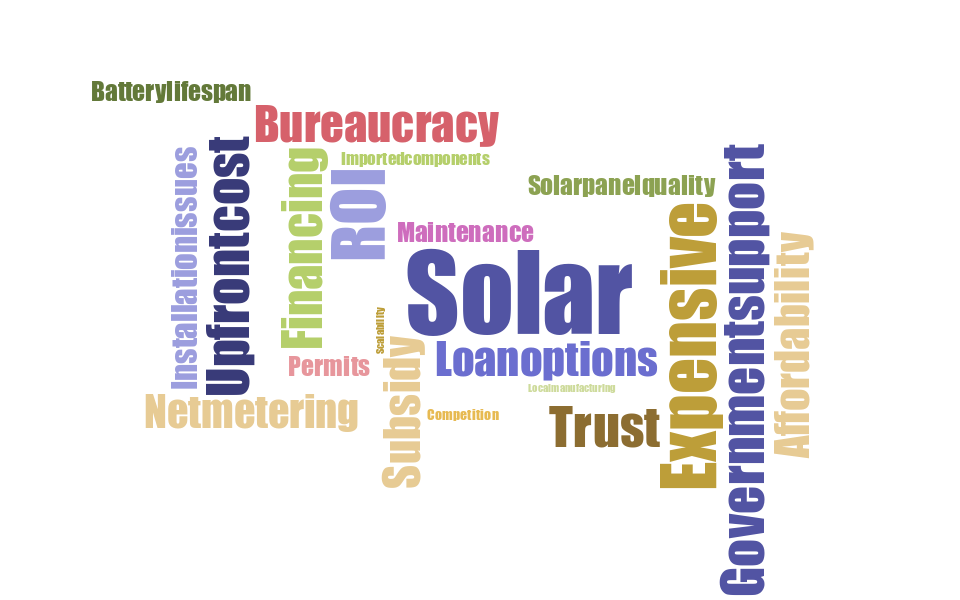
A word cloud generated from people’s responses on the Facebook post.
1. High cost of installation and ROI concerns
Many consumers cited the high initial cost of installing solar power systems as a major barrier. The upfront investment often matches several years’ worth of electricity bills, making it difficult for households to justify the expense. Additionally, long return-on-investment (ROI) periods discourage adoption, particularly in the absence of accessible financing options.
2. Lack of financing options
Access to financing remains a significant barrier to rooftop solar adoption. With limited options for low-interest loans or flexible payment schemes, households struggle to afford the initial investment, making solar installations less accessible to the broader public, especially to residential consumers.
3. Regulatory and bureaucratic hurdles
The slow and complex application process for net metering was another major concern. Many consumers reported waiting over six months and encountering excessive requirements that hindered their ability to connect their solar systems to the grid.
4. Service and maintenance issues
Some consumers highlighted issues related to improper system sizing, inefficiency, and high maintenance costs. Concerns included roof leaks due to poor installation, the lifespan of batteries, and the disposal of solar panels. These barriers make the transition to solar more challenging for prospective users.
5. Quality of solar technologies & local manufacturing
The absence of local solar manufacturers results in reliance on expensive imported components. Concerns about substandard or inefficient technologies make consumers hesitant to invest.
6. Lack of government support and incentives
Unlike countries such as Australia and Canada, which offer tax breaks, subsidies, and no-interest loans, the Philippine government provides minimal financial incentives for residential RTSP. This lack of support further discourages households from making the switch to solar energy.
7. Limited competition in the market
The industry is still dominated by a few major players, limiting consumer choices and competitive pricing. More players entering the market could drive innovation and lower costs through competition.
At New Energy Nexus Philippines, we recognize that overcoming these barriers requires a multi-faceted approach—one that not only enhances technical expertise but also builds trust within communities. This is why it’s important to empower the solar industry, especially smaller players, with the right tools and knowledge to drive solutions forward. Our programs, particularly the Solar Innovation Program (SIP) and Solar Community Meetups, are designed to do just that.
Strengthening the Solar Industry
SIP provides targeted support for solar PV installers, engineering, procurement, and construction (EPC) companies, and solar equipment suppliers to improve their competitiveness in the market. Through learning sessions and workshops, participants gain essential knowledge in:
By empowering solar entrepreneurs, SIP tackles concerns related to business growth, financing gaps, and limited competition in the market. A stronger and more competitive solar industry ultimately leads to better installation quality, reduced costs, and more accessible financing options for households.
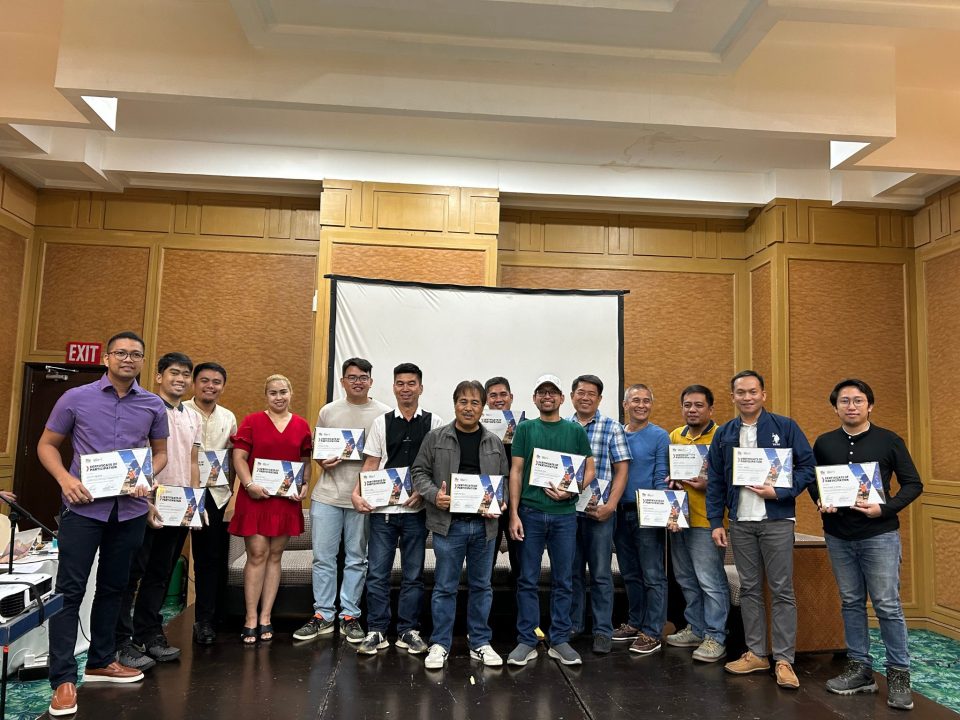
SIP 2024 graduates during the culminating activity in Cebu City.
Building Trust in the Industry
Beyond technical training, shifting public perception is crucial for accelerating RTSP adoption. Our Solar Community Meetups serve as a bridge between solar entrepreneurs, technical experts, policymakers, and consumers by fostering collaboration and knowledge-sharing. These gatherings provide a space for entrepreneurs to exchange insights and share best practices, address bureaucratic challenges with government stakeholders, streamline net metering processes, and advocate for stronger policy support. Additionally, they highlight success stories from early adopters, encouraging more households to consider solar power.
By fostering an ecosystem of collaboration and trust, Solar Community Meetups contribute to addressing skepticism and misinformation surrounding RTSP. The insights gathered from these discussions also help inform future policy recommendations, ensuring that the needs of solar entrepreneurs and consumers are effectively addressed.

DOE Assistant Secretary Mylene Capongcol presenting the Department of Energy’s renewable energy plans at the SCM in Davao.
The concerns raised in the Facebook post reflect the frustrations and aspirations of many Filipinos when it comes to solar energy adoption. While challenges such as high costs, bureaucratic red tape, and technical difficulties persist, programs like the SIP and Solar Community Meetups provide platforms that empower solar entrepreneurs to drive industry-wide improvements.
Panel discussion during the SIP 2024 culmination featuring Hon. Nestor Archival (Cebu City Government), Engr. Titus Ragrario (Jinko Solar), Engr. Richard Alfafara (Visayan Electric Company – VECO), and Engr. Woodrow Pino (Woodrow Solar Power), sharing insights on accelerating rooftop solar adoption. Photo
Ultimately, expanding the adoption of RTSP in the Philippines requires a collective effort from businesses, the government, private companies, and Filipino communities. By equipping solar entrepreneurs with knowledge and resources, and by fostering trust through community engagement, we can create a more inclusive and resilient solar industry that benefits both consumers and the environment.
Want to get more involved in the Filipino clean energy space? Learn more about our programs in the Philippines here.
A case for public funding that accelerates climate tech and pays off.
One of the biggest hurdles clean energy entrepreneurs face is bridging the “valley of death” between promising technology and a market-ready product. Since 2019, New Energy Nexus’s CalTestBed Initiative has tackled that challenge head-on (thanks to a US$22M investment made through the EPIC program by the California Energy Commission).
By offering startups vouchers for third-party testing at world-class facilities, CalTestBed helped 63 companies validate their technology, gain investor trust, and accelerate their path toward commercialization. The return?
A 19.9x multiplier:
Why it works: Trusted testing builds investor confidence
Startups received up to US$300,000 each in testing vouchers, redeemable at over 70 labs across Lawrence Berkeley National Lab and nine UC campuses. This provided them with access to rigorous, independent validation – exactly what investors and customers need to mitigate the risks associated with early-stage technologies.
And the benefits went beyond funding.
58% of companies that completed testing reported TRL advancement; on average, their Technology Readiness Level (TRL) increased by 2.1.
Several jumped from prototype to market-ready.
“We went from TRL 6 to 9,” said a representative from Delphire Inc., a grid tech company. “That shift helped us unlock market access and investor interest.”
Innovation in action: real-world success stories
The companies that came through CalTestBed aren’t just testing, they’re scaling:
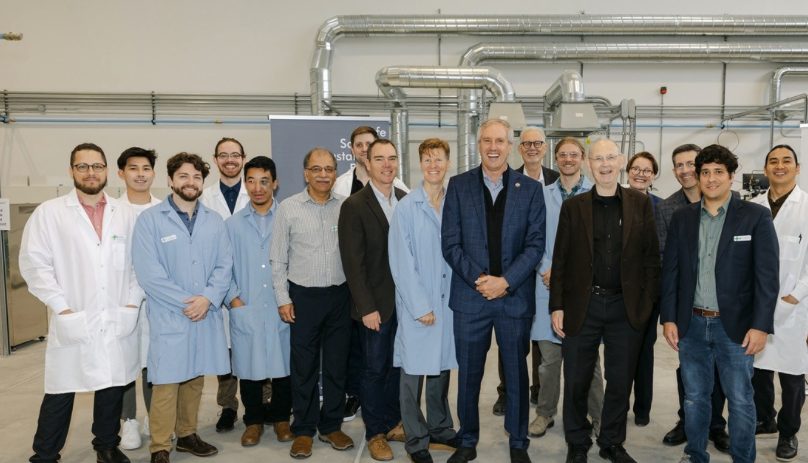
The Enzinc team at the facility’s ribbon-cutting ceremony.
Why Californians should care
The impact of CalTestBed goes beyond investor returns. For ratepayers, it means:
A smart bet on the future
CalTestBed, funded by the California Energy Commission’s EPIC program and administered by New Energy Nexus, is a model of how modest public investment of US$22M can unlock climate, economic, and equity wins. As the current funding cycle concludes in 2025, one thing is clear: this model works. It bridges the innovation gap, supports diverse entrepreneurs, and delivers value to investors and the public.
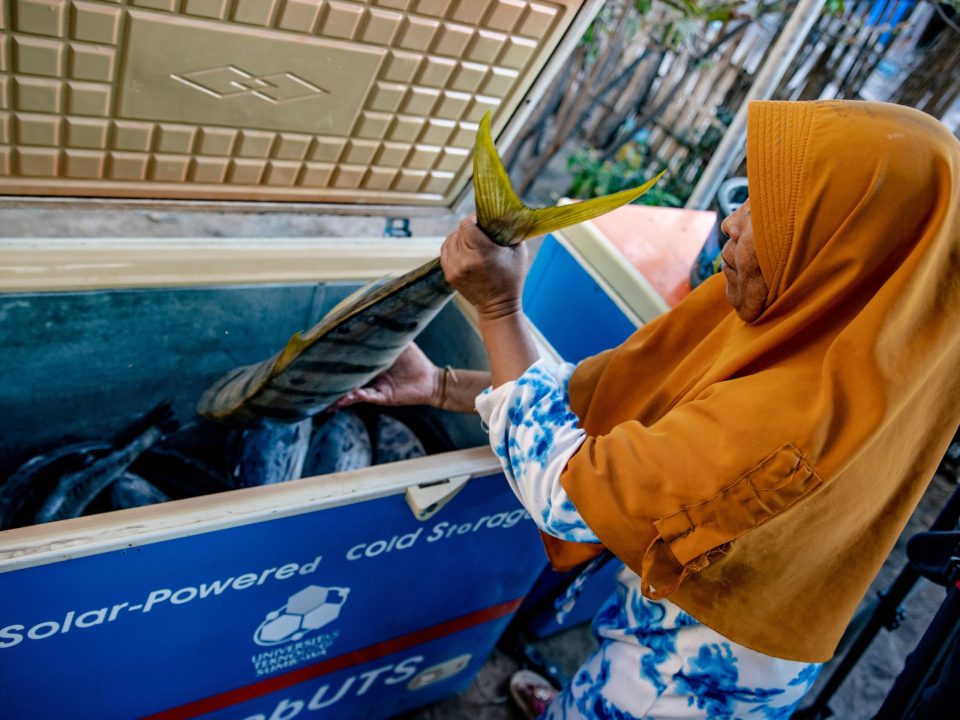
A resident of Bungin Village, Indonesia, uses solar-powered cold storage to store fish catch. Photo by Yudha Baskoro
Jakarta, 25 June 2025 — Up to 15 early-stage climate and clean energy startups will be eligible to win grants totaling IDR 1.6 billion (US$98,000), as well as mentoring and access to investors under a new program to support innovation across Indonesia.
The KINETIK NEX startup incubation program is led by New Energy Nexus and supported by KINETIK, the Australia-Indonesia Partnership for Climate, Renewable Energy and Infrastructure.
Five start-ups will be awarded funding for a total of IDR 1.6 billion to pilot their climate solutions.
The program will end with [RE]Spark, a clean energy and climate startup festival, where selected startups from the cohort will pitch their climate solutions to potential partners and investors. Under the program, journalists will also be trained in climate and clean energy reporting.
The KINETIK NEX aims to support Indonesia’s pledge to reach net-zero emissions by 2060 or earlier. Climate startups, which are critical to solving local challenges with homegrown solutions, continue to face barriers in accessing capital, market opportunities, and regulatory support. The initiative will prioritize women-led startups and those based in Eastern Indonesia.
According to a recent Climate Policy Initiative report, achieving Indonesia’s net-zero electricity target by 2060 will require renewable energy financing to increase more than five times, from around US$3 billion per year to approximately US$16 billion annually.
“Indonesia’s clean energy transition cannot succeed without empowering local innovators and ecosystem builders,” said Diyanto Imam, Director of New Energy Nexus Indonesia.
“Indonesia had huge clean energy potential, but fossil fuels still powered 80% of the country’s electricity. Through KINETIK NEX, we’re helping diverse startups to thrive and enabling local communities to drive clean energy solutions,” said Mr Imam.
“This is about unlocking talent and ideas from every corner of Indonesia, and making the energy transition inclusive, equitable, and locally driven.”
About KINETIK NEX
KINETIK NEX Initiative drives inclusive growth by supporting clean energy and climate startups and businesses across Indonesia.
Led by New Energy Nexus Indonesia with support from KINETIK, the Australia-Indonesia Partnership for Climate, Renewable Energy and Infrastructure, we champion local innovators, grow green jobs, and bring climate solutions to life beyond urban centres.
KINETIK NEX backs bold ideas for a prosperous Indonesia and a protected planet.
About New Energy Nexus Indonesia
New Energy Nexus is the world’s leading ecosystem of funds and accelerators supporting diverse clean energy entrepreneurs. In Indonesia, New Energy Nexus works to support the development of ecosystems that can support the needs of not only innovators, startups, and entrepreneurs, but also other stakeholders in the clean energy and climate solutions sectors.
Raisha Fatya
Communications Manager, New Energy Nexus Indonesia
raisha.fatya@newenergynexus.com
+628118980051
About New Energy Nexus
New Energy Nexus (NEX) is an international organization that strives towards a 100% clean energy economy for 100% of the population. It does this with a laser focus on diverse entrepreneurs, supporting them with accelerators, funds, skills, and networks they need to thrive. NEX has accelerated 1,500+ startups, empowered over 10,400+ entrepreneurs, and mobilized over US$4.7 billion in investment. Since its founding in California in 2004, NEX now operates programs or advisory services in Australia, China, India, Indonesia, Nigeria, Pakistan, the Philippines, Thailand, the UAE, Uganda, the USA (California and New York), and Vietnam.
The clean energy transition is our chance to build a fairer future, yet women are still missing from the table. Around the world, only 15% of clean energy leadership roles are held by women.
Even in Thailand, a leader in the Asia Pacific region when it comes to women’s leadership in the energy sector, women occupy just 23% of leadership positions.
But when women are at the helm, the impact speaks for itself.

Salinee Hurley. Photo from SunSawang
Salinee Hurley is proof that inclusive leadership powers inclusive solutions. A mechanical engineer specializing in solar, she founded SunSawang: a social enterprise bringing solar home systems and lanterns to off-grid villages along the Thailand–Myanmar border. She is also the Project Director at the Border Green Energy Team (BGET), an organization advancing clean energy access in the region.
Salinee’s journey into solar began when she pursued further studies in solar engineering in the United States. Returning to Thailand, she initially implemented solar projects through an NGO model, using grant funding to provide free installations in remote areas. Over time, she realized the approach lacked long-term sustainability.
To address this, Salinee transitioned to a social enterprise model, offering long-term payment plans that support both ongoing maintenance and local ownership.
“Free installations may help in the short term, but the real goal is to empower people to access energy independently in the long run,” she said.
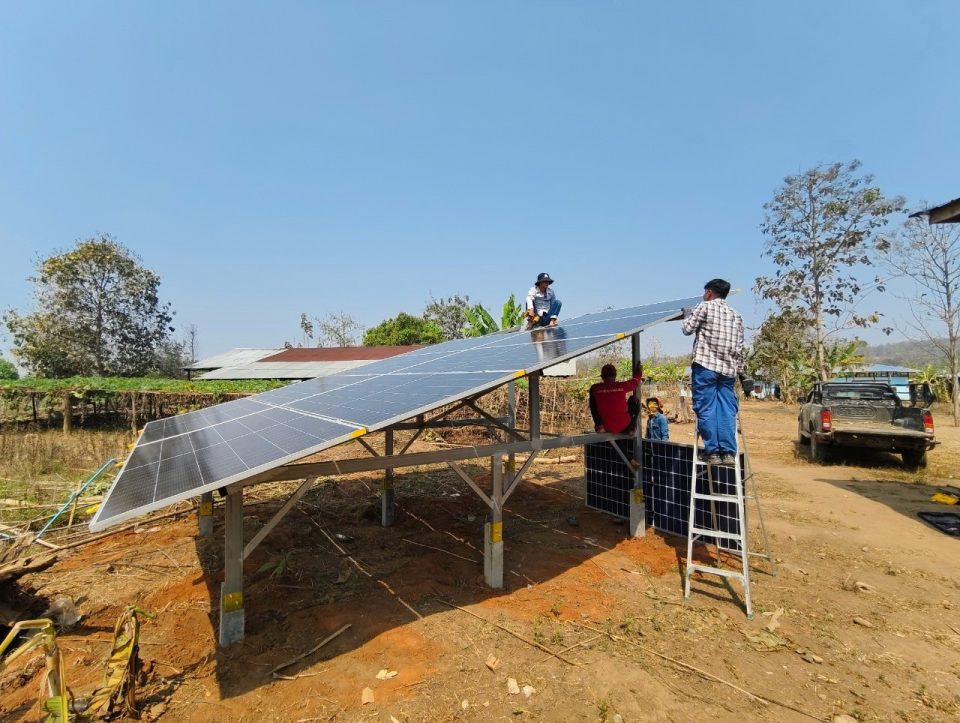
Solar installation at Maw Poe Kay High School. Photo from SunSawang
SunSawang now trains and hires local technicians and sales agents to serve their own communities. This localized model not only keeps systems functioning, but also supports economic activity—access to reliable electricity allows for evening work like weaving, increasing household income.
Salinee’s work also highlights the systemic barriers that persist in Thailand’s solar landscape: high upfront costs, inconsistent regional regulations, and limited financing options for low-income households. Recent steps, including draft laws to simplify rooftop solar permitting and new green loan products, are promising, but access remains uneven.
Last year, she joined New Energy Nexus Thailand’s SolarSTEP initiative, where she shared her expertise and connected with other women leading the shift to a cleaner energy future.
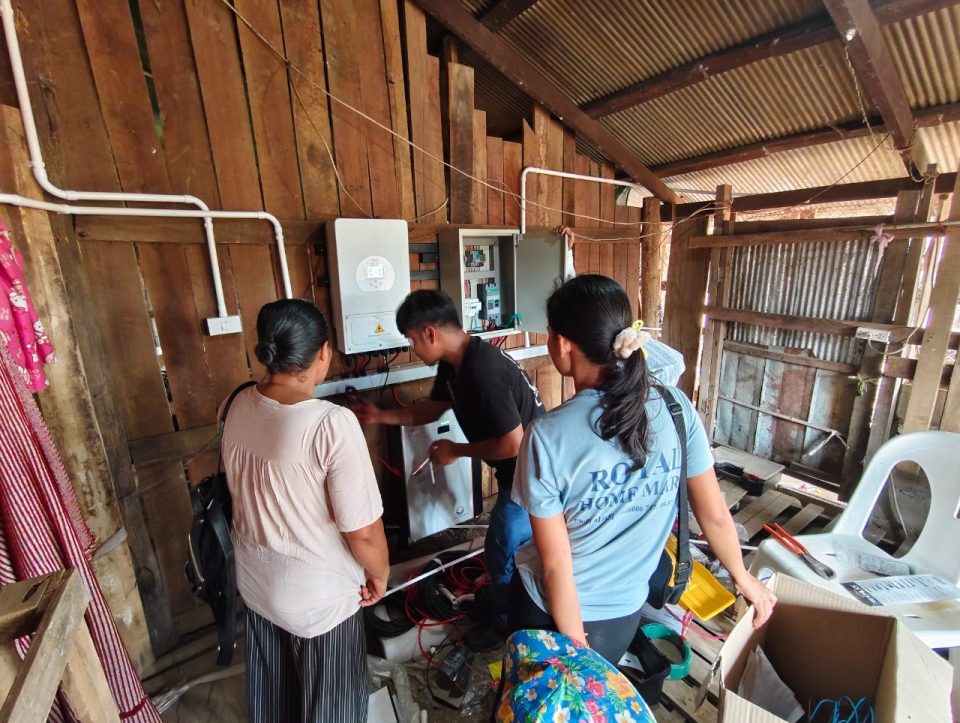
Solar installation at Maw Poe Kay High School. Photo from SunSawang
SolarSTEP is designed to build skills and leadership among solar technicians and entrepreneurs, with a focus on women, to help accelerate Thailand’s clean energy transition.
This work is spurred on by Thailand’s ambitious target to reach 12,139 MW of solar capacity by 2037, as outlined in its Alternative Energy Development Plan (AEDP). Hitting this target will take more than policy; it requires investing in people, empowering women, and expanding access to rooftop solar across the country.
This is where SolarSTEP comes in. The program has already delivered seven trainings across Thailand’s Central, Northern, and Southern regions, reaching over 200 participants. These efforts have been strengthened through collaboration with key partners, including PEA Encom Smart Solution, PEA Encom International, and LONGi.
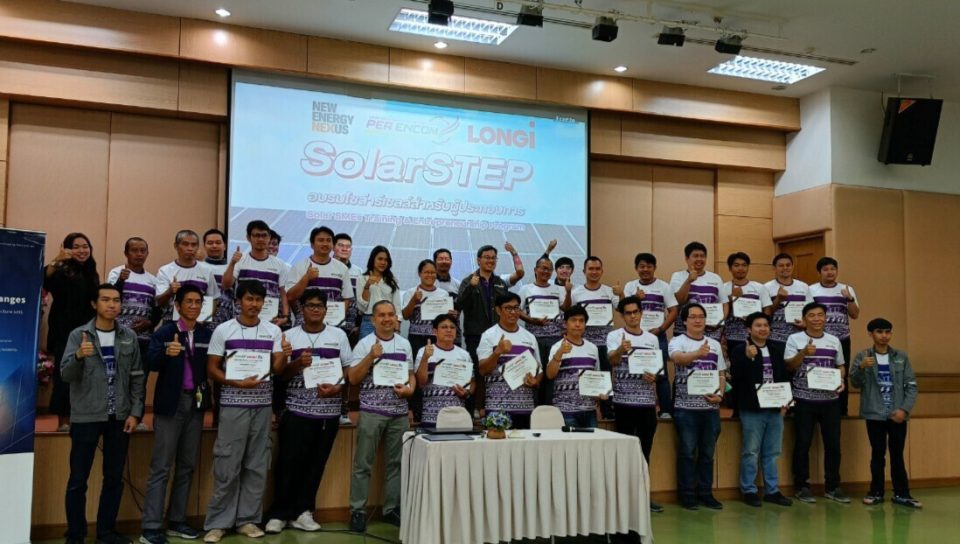
Photo of the SolarSTEP 2024 Training program participants, including Salinee Hurley.
Looking ahead, we’re focused on scaling impact, broadening solar access, and building a sector that mirrors the diversity of the communities it serves.
If we want a just and resilient clean energy future, we need to break down the barriers that keep women on the sidelines and back those already leading the way. Empowering more women to participate and lead in clean energy isn’t just the right thing to do—it’s the smart thing to do.
Want to be part of building an inclusive clean energy sector in Thailand? Learn more about our work here.
Australia is charging ahead in the race to build a battery-powered world—and the timing couldn’t be better.
The nation’s growing role in the global battery supply chain took center stage at our recent webinar, Australia’s Time to Charge: Powering the Battery Future. The hour-long session, part of our Just Batteries initiative, explored how battery innovation, mass EV retrofitting, and smart policy could transform Australia into a clean energy powerhouse.
These industry experts led the discussion, held virtually on June 19, 2025:
Why this conversation matters
The battery supply chain is the backbone of the energy transition, and Australia’s unique mix of critical minerals, renewable energy resources, supportive policies, and skilled workforce positions it to lead the way.
This is what we’re backing through Supercharge Australia, a collaboration between New Energy Nexus and EnergyLab. The program aims to support 150+ local startups, empowering them with mentorship, funding pathways, and global connections to expand Australia’s lithium battery value chain.
6 key insights from the webinar
1. Australia’s global opportunity is now
Australia is well-positioned to become a significant player in the battery-powered electrical transformation. Here’s why:
There are signals from state and federal governments that they want to move away from a fossil fuel-based export economy, such as:
2. Mass EV retrofits could boost battery demand 20-fold
Retrofitting existing vehicles—especially commercial fleets—is a faster, cheaper, and lower-carbon way to scale EV adoption. Our second Supercharge Australia Innovation Challenge spotlighted 12 startups electrifying everything from mining trucks to boats.
The current projection of a 65GWh demand for stationary storage by 2030 could be massively higher with mass EV retrofits. Multiplying Australia’s vehicles by their estimated battery capacity, turning half of Australia’s vehicle fleet into EVs could multiply local battery demand 20-fold to over 1.3TWh, enough to justify domestic cell production and build a full onshore value chain (more here).
3. Startups like Veepower are leading the way
Kyle Van Berendonck, founder of Veepower and Retrofit Nation challenge winner, introduced Veepilot: a drop-in EV brain that lets large garages and re-manufacturers, through to individual garages, convert vehicles to electric with professional and supportable software — a key concern of retrofit solutions.
After a tour of California’s thriving clean energy ecosystem with New Energy Nexus, Veepower is now raising AU$500K from climate-focused investors to scale in Australia.
4. Smart policy can unlock big impact
The discussion emphasized the need for policies to support battery retrofits, including:
These interventions could support thousands of upskilled ICE workers (such as mechanics and automotive electricians) and create a more circular, cost-effective battery and transportation economy.
5. Startup support is critical
Through tailored workshops, mentorship, and investor-readiness training, the Supercharge Australia Incubator aims to help founders bridge key gaps in prototyping, lab access, and commercialization. As Kirk McDonald and EnergyLab project lead Derick Gyabeng said in the webinar, early-stage startups need consistent, generous support to grow from an idea to an investment-ready solution.
Moreover, Supercharge Australia is leading a push to bring learnings from California’s best practice startup testing program, CalTestBed, to Australia. As part of the CalSEED-CalTestBed pair offering US$1M in non-matching and non-dilutive support to founders, startups can receive vouchers up to US$300K in value to use at the University of California and National Labs testing facilities across the state.
CalTestBed has supported over 150 startups with $45M in vouchers, with over 40% being received by women and under-represented founders.
6. Australia’s Leadership Can Power the Region
The country’s battery innovation doesn’t stop at its borders. With Southeast Asia on the path to rapid electrification, Australia’s EV retrofitting industry can serve a region set to reach 770 million people by 2050.
Supporting Australia’s battery supply chain at this stage could play a huge role in the region’s clean energy transition.
Why ‘Just Batteries’
Batteries are the linchpin of the clean energy transition. But how we build this industry matters as much as how fast we scale it.
At New Energy Nexus, we believe battery innovation must be just, inclusive, and community-led. Today, the battery supply chain is dominated by a few countries and companies, with little accountability to communities, workers, or the environment. Battery recycling and reuse are underinvested solutions. And left unchecked, the race for minerals and manufacturing could replicate the injustices of the fossil fuel era.
This is what our Just Batteries initiative addresses. We have supported 116 startups across the battery value chain—from extraction to recycling—while shaping an innovation ecosystem rooted in equity, access, and sustainability.
Our work spans the full ecosystem, from startup accelerators and testbeds to international market access, because building a clean energy future means backing entrepreneurs at every stage.
Join us, invest in these startups, and let’s supercharge the transition in Australia and beyond. Check out how you can support this initiative and more here.
The clean energy transition requires new ideas for deploying existing tech, especially in emerging markets such as Thailand. And startups are ready to take on the challenge.
At the Decarbonize Thailand Symposium 2025, co-hosted by New Energy Nexus Thailand and True Digital Park, 37 startups from around the world showcased breakthrough technologies that could drive the country’s clean energy future.
These nine startups represent some of the most promising clean energy and climate solutions across Asia and beyond – with fresh ideas, unique technologies, and growing relevance to New Energy Nexus’ mission of driving decarbonisation and accelerating the adoption of clean technologies.

GeoAgni presenting at the Decarbonize Thailand Symposium 2025.
GeoAgni (Thailand)
Harnessing Thailand’s geothermal energy potential
GeoAgni is a geothermal power plant developer specializing in closed-loop systems that provide 24/7 stable, clean energy. Their scalable, low-impact technology supports Thailand’s energy security and carbon neutrality goals, offering a commercially viable solution for sustainable, locally produced renewable energy in industrial and grid applications.
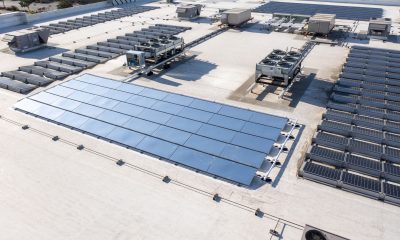
Photo from Skycool’s website
SkyCool Systems (US)
Changing the game for urban cooling
SkyCool is the first in the world to develop a passive radiative cooling film that can keep any surface 5° to 8°C below the ambient temperature, just by being outside and under the sky. The film eliminates solar heat gain, reduces heating, ventilation, and air conditioning (HVAC) energy costs, and creates ‘cool’ islands in cities.

Climind presenting at the Decarbonize Thailand Symposium 2025.
Climind (Hong Kong)
AI-powered carbon analysis
Climind is an AI platform for sustainability, offering enterprise-level search, ESG and climate report analysis, content generation, and carbon trading insights. It integrates corporate climate data, enhancing efficiency and decision-making. Through precise search, automated reporting, and AI-driven regulatory analysis, it aims to advance climate research, predict patterns, and drive low-carbon transformation.
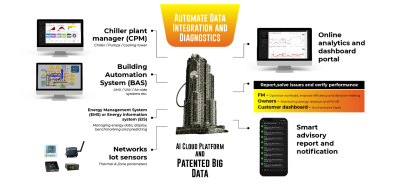
Image from T-Smart’s website
TIE Smart Solutions (Thailand)
AIoT-driven energy savings across Thailand
T-Smart is a tech-driven energy solutions startup specializing in Artificial Intelligence of Things (AIoT)-powered energy management for buildings and factories. They provide various technologies that help clients achieve up to 20 percent in energy savings while enhancing sustainability, operational efficiency, and long-term performance across Thailand.
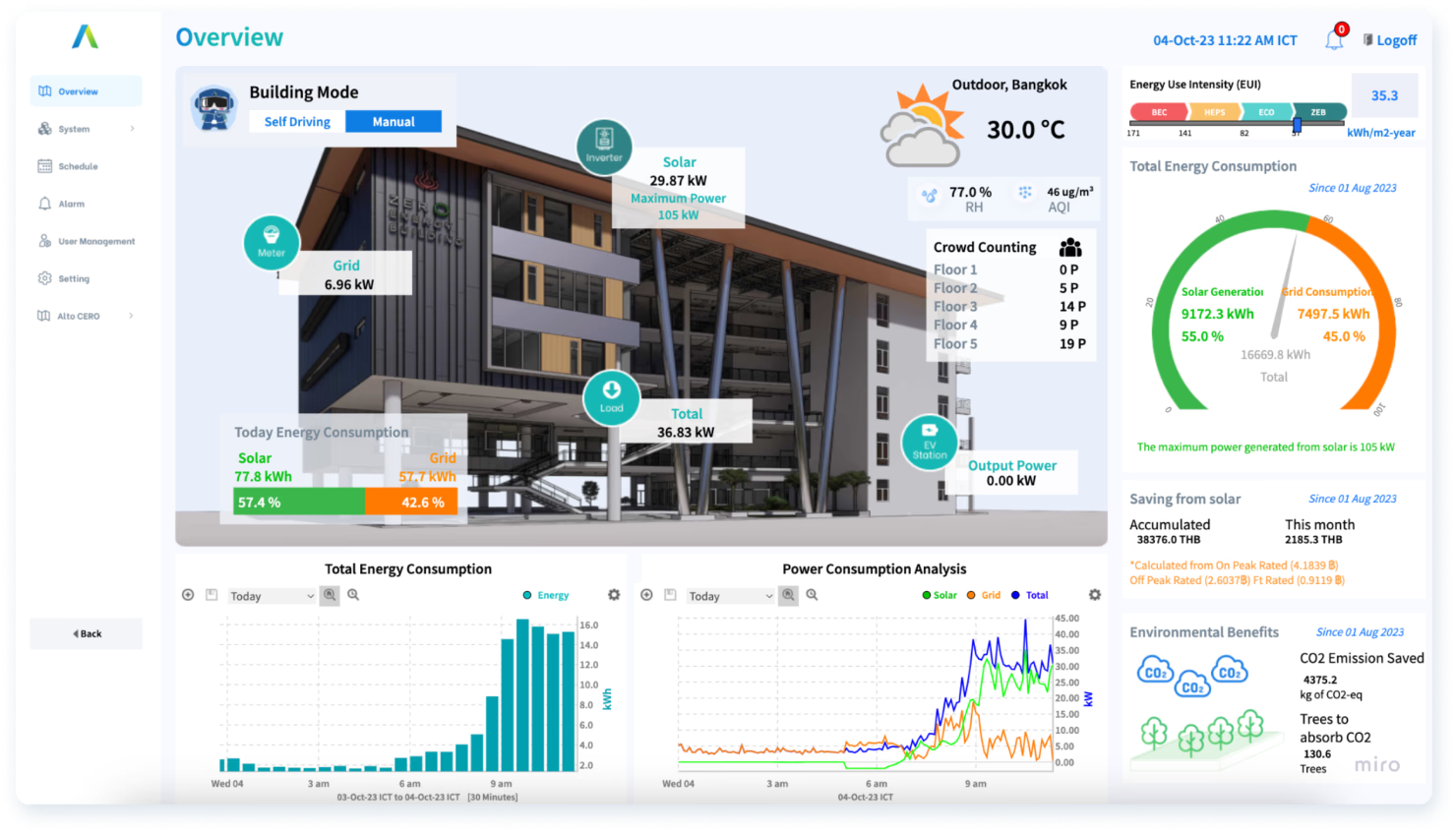
Screenshot of the Alto CERO system for buildings. Image from Altotech Global’s website.
AltoTech Global (Thailand)
Lower carbon, energy costs through AI algorithms
AltoTech’s Alto CERO system helps hotels, buildings, and factories to effectively consume energy and cut carbon emissions with Internet of Things (IoT) and AI algorithms. Their technology promises users can save up to 40 percent in energy costs, reduce their carbon footprint by 40 percent, and expect an attractive payback period of less than 3 years.
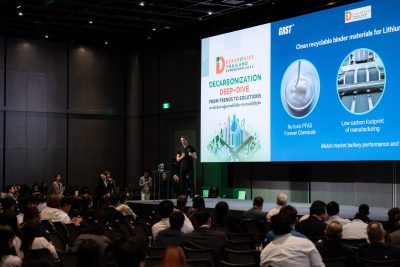
GRST presenting at the Decarbonize Thailand Symposium 2025.
GRST (Hong Kong)
Safer binder materials driving battery circularity
GRST (Green Renewable Sustainable Technology) makes eco-friendly lithium-ion binder materials, which remove toxic PFAS or “forever chemicals” from lithium-ion batteries and make them easily recyclable in water. Their binder materials match industry performance and cost across all lithium-ion battery types, integrate easily into existing battery production, and are proven at commercial scale in their 1 GWh battery factory. They aim to become the global standard for eco-friendly binder materials, enabling clean circular battery production.
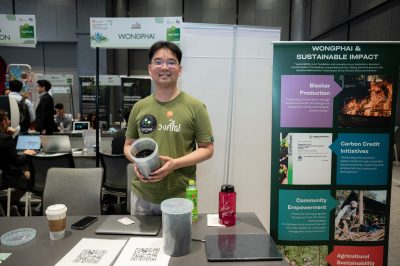
Wongphai’s booth at the Decarbonize Thailand Symposium 2025.
Wongphai (Thailand)
Reducing carbon pollution through biochar
Wongphai is a sustainability solutions provider, transforming agricultural waste into accessible wealth. Contrary to the tradition of burning bamboo offcuts, Wongphai instead turns them into biochar or organic charcoal, eliminating potential carbon emissions. This biochar not only increases soil quality and crop yield, but also reduces methane emissions when used in septic ponds for pig farms. Through this regenerative agricultural solution, the startup aims to empower communities and drive a circular economy in the country.
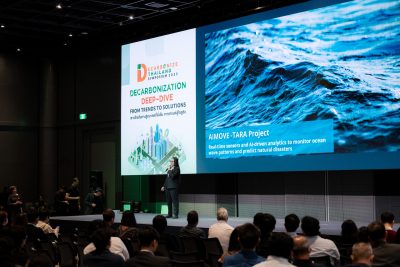
AIMOVE-TARA Project presented at the Decarbonize Thailand Symposium 2025.
AIMOVE-TARA Project (Thailand)
AI system aiming to unlock wave energy potential
This project is developing a real-time sensor and AI-driven analytics system, which monitors ocean wave patterns—data that can be widely used to calculate the energy potential of ocean wave power. This supports the future development of green energy generators and allows for the accurate prediction of natural disasters, like tsunamis and other related events.
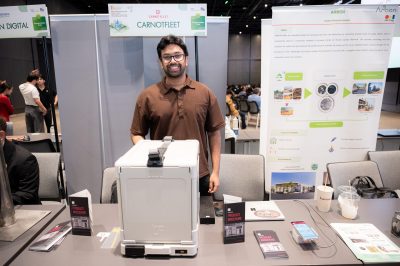
Carnotfleet’s booth at the Decarbonize Thailand Symposium 2025.
Carnotfleet (Singapore)
De-risking transport cooling systems
Carnotfleet’s plug-and-play cold chain system provides temperature control for transport and logistics. These products can be installed in existing non-refrigerated vehicles, turning them into temperature-controlled units in minutes with no upfront cost. These units are then controlled, optimized, and monitored with data connected to the cloud. The technology de-risks the cold chain and minimizes the business and environmental impacts of loss due to human error.
Entrepreneurs in Thailand and beyond are brimming with ideas. Imagine the possibilities when a strong ecosystem is backing them up, providing them with the connections and resources they need to take the next step.
This ecosystem-building work is what we do best at New Energy Nexus. Our Thai team organized this event intending to cast a global net on climate and clean energy innovators—in total, over 500 participants from various sectors converged in Bangkok to exchange insights on decarbonization and build relationships in the field.
From here, they will be part of a massive, global community of like-minded startups, industry experts, and potential investors, giving them new pathways to scale their business to a wider market.
Find out more about our work in Thailand.